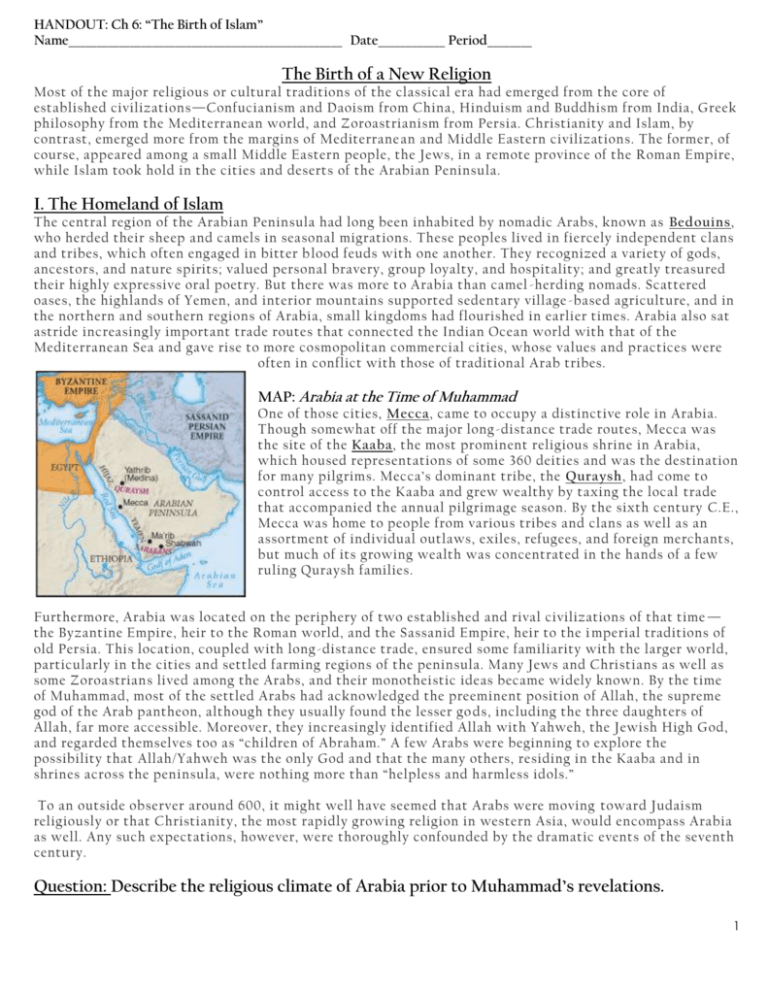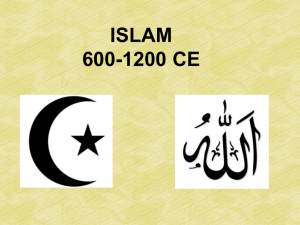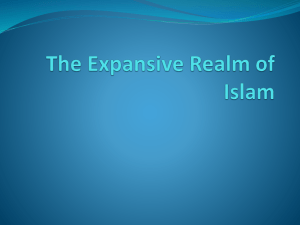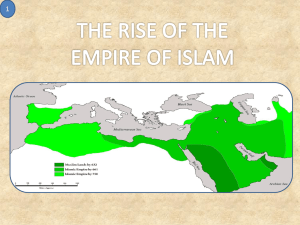The Birth of a New Religion - North Penn School District
advertisement

HANDOUT: Ch 6: “The Birth of Islam” Name_________________________________________________ Date____________ Period________ The Birth of a New Religion Most of the major religious or cultural traditions of the classical era had emerged from the core of established civilizations—Confucianism and Daoism from China, Hinduism and Buddhism from India, Greek philosophy from the Mediterranean world, and Zoroastrianism from Persia. Christianity and Islam, by contrast, emerged more from the margins of Mediterrane an and Middle Eastern civilizations. The former, of course, appeared among a small Middle Eastern people, the Jews, in a remote province of the Roman Empire, while Islam took hold in the cities and deserts of the Arabian Peninsula. I. The Homeland of Islam The central region of the Arabian Peninsula had long been inhabited by nomadic Arabs, known as Bedouins, who herded their sheep and camels in seasonal migrations. These peoples lived in fiercely independent clans and tribes, which often engaged in bitter b lood feuds with one another. They recognized a variety of gods, ancestors, and nature spirits; valued personal bravery, group loyalty, and hospitality; and greatly treasured their highly expressive oral poetry. But there was more to Arabia than camel -herding nomads. Scattered oases, the highlands of Yemen, and interior mountains supported sedentary village -based agriculture, and in the northern and southern regions of Arabia, small kingdoms had flourished in earlier times. Arabia also sat astride increasingly important trade routes that connected the Indian Ocean world with that of the Mediterranean Sea and gave rise to more cosmopolitan commercial cities, whose values and practices were often in conflict with those of traditional Arab tribes. MAP: Arabia at the Time of Muhammad One of those cities, Mecca, came to occupy a distinctive role in Arabia. Though somewhat off the major long -distance trade routes, Mecca was the site of the Kaaba, the most prominent religious shrine in Arabia, which housed representations of some 360 deities and was the destination for many pilgrims. Mecca’s dominant tribe, the Quraysh, had come to control access to the Kaaba and grew wealthy by taxing the local trade that accompanied the annual pilgrimage season. By the sixth century C.E., Mecca was home to people from various tribes and clans as well as an assortment of individual outlaws, exiles, refugees, and foreign merchants, but much of its growing wealth was concentrated in the hands of a few ruling Quraysh families. Furthermore, Arabia was located on the periphery of two established and rival civilizations of that time — the Byzantine Empire, heir to the Roman world, and the Sassanid Empire, heir to the i mperial traditions of old Persia. This location, coupled with long -distance trade, ensured some familiarity with the larger world, particularly in the cities and settled farming regions of the peninsula. Many Jews and Christians as well as some Zoroastrians lived among the Arabs, and their monotheistic ideas became widely known. By the time of Muhammad, most of the settled Arabs had acknowledged the preeminent position of Allah, the supreme god of the Arab pantheon, although they usually found the lesser go ds, including the three daughters of Allah, far more accessible. Moreover, they increasingly identified Allah with Yahweh, the Jewish High God, and regarded themselves too as “children of Abraham.” A few Arabs were beginning to explore the possibility that Allah/Yahweh was the only God and that the many others, residing in the Kaaba and in shrines across the peninsula, were nothing more than “helpless and harmless idols.” To an outside observer around 600, it might well have seemed that Arabs were moving toward Judaism religiously or that Christianity, the most rapidly growing religion in western Asia, would encompass Arabia as well. Any such expectations, however, were thoroughly confounded by the dramatic events of the seventh century. Question: Describe the religious climate of Arabia prior to Muhammad’s revelations. 1 II. The Messenger and the Message The catalyst for those events and for the birth of this new religion was a single individual, Muhammad Ibn Abdullah (570–632 C.E.), who was born in Mecca to a Quraysh family. As a young boy, Muhammad lost his parents, came under the care of an uncle, and worked as a shepherd to pay his keep. Later he became a trader and traveled as far north as Syria. At the age of twenty -five, he married a wealthy widow, Khadija, herself a prosperous merchant, with whom he fathered six children. A highly refle ctive man deeply troubled by the religious corruption and social inequalities of Mecca, he often undertook periods of withdrawal and meditation in the arid mountains outside the city. There, like the Buddha and Jesus, Muhammad had a powerful, overwhelming religious experience that left him convinced, albeit reluctantly, that he was Allah’s messenger to the Arabs, commissioned to bring to them a scripture in their own language. According to Muslim tradition, the revelations began in 610 and continued periodically over the next twenty-two years. Those revelations, recorded in the Quran, became the sacred scriptures of Islam, which to this day Muslims everywhere regard as the very words of God and the core of their faith. Intended to be recited rather than simply read for information, the Quran, Muslims claim, when heard in its original Arabic, conveys nothing less than the very presence of the divine. Its unmatched poetic beauty, m iraculous to Muslims, convinced many that it was indeed a revelation from God. One of the earliest converts testified to its power: “When I heard the Quran, my heart was softened and I wept and Islam entered into me.” PAINTING: Muslims, Jews, and Christians The close relationship of three Middle Eastern monotheistic traditions is illustrated in this fifteenth-century Persian painting, which portrays Muhammad leading Moses, Abraham, and Jesus in prayer. The fire surrounding the prophet’s head represents his religious fervor. The painting reflects the Islamic belief that the revelations granted to Muhammad built upon and completed those given earlier to Jews and Christians. In its Arabian setting, the Quran’s message, delivered through Muhammad, was revoluti onary. Religiously, it was radically monotheistic, presenting Allah as the only God, the all -powerful Creator, good, just, and merciful. It rejected as utterly false and useless the many gods housed in the Kaaba and scorned the Christian notion of the Trinity. Allah was the “Lord sustainer of the worlds, the Compassionate, the Caring, master of the day of reckoning.” Here was an exalted conception of the Deity that drew heavily on traditions of Jewish and Christian monotheism. As “the Messenger of God,” Muh ammad presented himself in the line of earlier prophets—Abraham, Moses, Jesus, and many others. He was the last, “the seal of the prophets,” bearing God’s final revelation to humankind. It was not so much a call to a new faith as an invitation to return to the old and pure religion of Abraham from which Arabs, Jews, and Christians alike had deviated. Submission to Allah (“Muslim” means “one who submits”) was the primary obligation of believers and the means of achieving a place in paradise after death. Acco rding to the Quran, however, submission was not merely an individual or spiritual act, for it involved the creation of a whole new society. Over and again, the Quran denounced the prevailing social practices of an increasingly prosperous Mecca: the hoardin g of wealth, the exploitation of the poor, the charging of high rates of interest on loans, corrupt business deals, the abuse of women, and the neglect of the widows and orphans. Like the Jewish prophets of the Old Testament, the Quran demanded social just ice and laid out a prescription for its implementation. It sought a return to the older values of Arab tribal life —solidarity, equality, concern for the poor —which had been undermined, particularly in Mecca, by growing wealth and commercialism. Question: Compare the beliefs of Islam to Judaism & Christianity. 2 The message of the Quran challenged not only the ancient polytheism of Arab religion and the social injustices of Mecca but also the entire tribal and clan structure of Arab society, which was so prone to war, feuding, and violence. The just and moral soci ety of Islam was the umma, the community of all believers, replacing tribal, ethnic, or racial identities. Such a society would be a “witness over the nations,” for according to the Quran, “You are the best community evolved for mankind, enjoining what is right and forbidding what is wrong.” In this community, women too had an honored and spiritually equal place. “The believers, men and women, are protectors of one another,” declared the Quran. The umma, then, was to be a new and just community, bound by a common belief, rather than by territory, language, or tribe. III. The Five Pillars The core message of the Quran—surrendering to the divine—was effectively summarized as a set of five requirements for believers, known as the Pillars of Islam. The first pillar expressed the heart of the Islamic message: “There is no god but Allah, and Muhammad is the messenger of God.” The second pillar was prayer, to be performed five times a day while facing in the direction of Mecca. The accompanying ritual s, including cleansing, bowing, kneeling, and prostration, expressed believers’ submission to Allah and provided a frequent reminder, amid the busyness of daily life, that they were living in the presence of the divine. The third pillar, almsgiving, reflected the Quran’s repeated demands for social justice by requiring believers to give generously to support the poor and needy of the community. The fourth pillar established a month of fasting during Ramadan, which meant abstaining from food, drink, and sexu al relations from the first light of dawn to sundown. It provided an occasion for self -purification and a reminder of the needs of the hungry. The fifth pillar encouraged a pilgrimage to Mecca, known as the hajj, where believers from all over the Islamic world assembled once a year and put on identical simple white clothing as they performed together rituals reminding them of key events in Islamic history. For at least the few days of the hajj, the many worlds of Islam must surely have seemed a single realm . A further requirement for believers, sometimes called the sixth pillar, was “struggle,” or jihad in Arabic. Its more general meaning, which Muhammad referred to as the “greater jihad,” was an interior personal effort of each Muslim against greed and sel fishness, a spiritual striving toward living a God -conscious life. In its “lesser” form, the “jihad of the sword,” the Quran authorized armed struggle against the forces of unbelief and evil as a means of establishing Muslim rule and of defending the umma from the threats of infidel aggressors. The understanding and use of the jihad concept has varied widely over the many centuries of Islamic history and remains a matter of controversy among Muslims in the twenty -first century. IV. Reactions to Islam As the revelations granted to Muhammad became known in Mecca, they attracted a small following o f some close relatives, a few prominent Meccan leaders, and an assortment of lower -class dependents, freed slaves, and members of poorer clans. Those teachings also soon attracted the vociferous opposition of Mecca’s elite families, particularly those of Muhammad’s own tribe, the Quraysh. Muhammad’s claim to be a “messenger of Allah,” his unyielding monotheism, his call for social reform, his condemnation of Mecca’s business practices, and his apparent disloyalty to his own tribe enraged the wealthy and rul ing families of Mecca. So great had this opposition become that in 622 Muhammad and his small band of followers emigrated to the more welcoming town of Yathrib, soon to be called Medina, the city of the Prophet. This agricultural settlement of mixed Arab and Jewish population had invited Muhammad to serve as an arbitrator of their intractable conflicts. The emigration to Yathrib, known in Arabic as the hijra, was a momentous turning point in the early history of Islam and thereafter marked the beginning of a new Islamic calendar. The Islamic community, or umma, that took shape in Medina was a kind of “supertribe,” but very different from the traditional tribes of Arab society. Membership was a matter of belief rather than birth, allowing the community to expand rapidly. Furthermore, all authority, both political and religious, was concentrated in the hands of Muhammad, who proceeded to introduce radical changes. Usury was outlawed, tax -free marketplaces were established, and a mandatory payment to support th e poor was imposed. 3 In Medina, Muhammad not only began to create a new society but also declared Islam’s independence from its earlier affiliation with Judaism. In the early years, he had anticipated a warm response from Jews and Christians, based on a common monotheism and prophetic tradition, and had directed his followers to pray facing Jerusalem. But when some Jewish groups allied with his enemies, Muhammad acted harshly to suppress them, exiling some and enslaving or killing others. This was not, howev er, a general suppression of Jews, since others among them remained loyal to Muhammad’s new state. But the prophet now redirected Muslims’ prayer toward Mecca, essentially declaring Islam an Arab religion, though one with a universal message. From its base in Medina, the Islamic community rapidly extended its reach throughout Arabia. Early military successes against Muhammad’s Meccan opponents convinced other Arab tribes that the Muslims and their God were on the rise, and they sought to negotiate alliance s with the new power. Growing numbers, though not all, converted. The religious appeal of the new faith, its promise of material gain, the end of incessant warfare among feuding tribes, periodic military actions skillfully led by Muhammad, and the Prophet’s willingness to enter into marriage alliances with leading tribes —all of this contributed to the consolidation of Islamic control throughout Arabia. In 630, Muhammad triumphantly and peacefully entered Mecca itself, purging the Kaaba of its idols and decl aring it a shrine to the one God, Allah. By the time Muhammad died in 632, most of Arabia had come under the control of this new Islamic state, and many had embraced the new faith. Thus the birth of Islam differed sharply from that of Christianity. Jesus’ teaching about “giving to Caesar what is Caesar’s and to God what is God’s” reflected the minority and subordinate status of the Jews within the Roman Empire. Early Christians found themselves periodically persecuted by Roman authorities for more than three centuries, requiring them to work out some means of dealing with an often hostile state. The answer lay in the development of a separate church hierarchy and the concept of two coexisting authorities, one religious and one political, an arrangement that persisted even after the state became Christian. The young Islamic community, by contrast, found itself constituted as a state, and soon a huge empire, at the very beginning of its history. Muhammad was not only a religious figure but also, unlike Jesus or the Buddha, a political and military leader able to implement his vision of an ideal Islamic society. Nor did Islam give rise to a separate religious organization, although tension between religious and political goals frequently generated conflict. No professional clergy mediating between God and humankind emerged within Islam. Teachers, religious scholars, prayer leaders, and judges within an Islamic legal system did not have the religious role that priests held within Christianity. No distinction betw een religious law and civil law, so important in the Christian world, existed within the realm of Islam. One law, known as the sharia, regulated every aspect of life. The sharia (literally, a path to water, which is the source of life) evolved over the several centuries following the birth of this new religion and found expression in a number of separate schools of Islamic legal practice. In little more than twenty years (610 –632), a profound transformation had occurred in the Arabian Peninsula. A new religion had been born, though one that had roots in earlier Jewish, Christian, and Zoroastrian traditions. A new and vigorous state had emerged, bringing peace to the warring tribes of Arabia. Within that state, a distinctive society had begun to take shape, one that served ever after as a model for Islamic communities everywhere. Question: In what ways was the rise of Islam revolutionary, both in theory and in practice? 4








